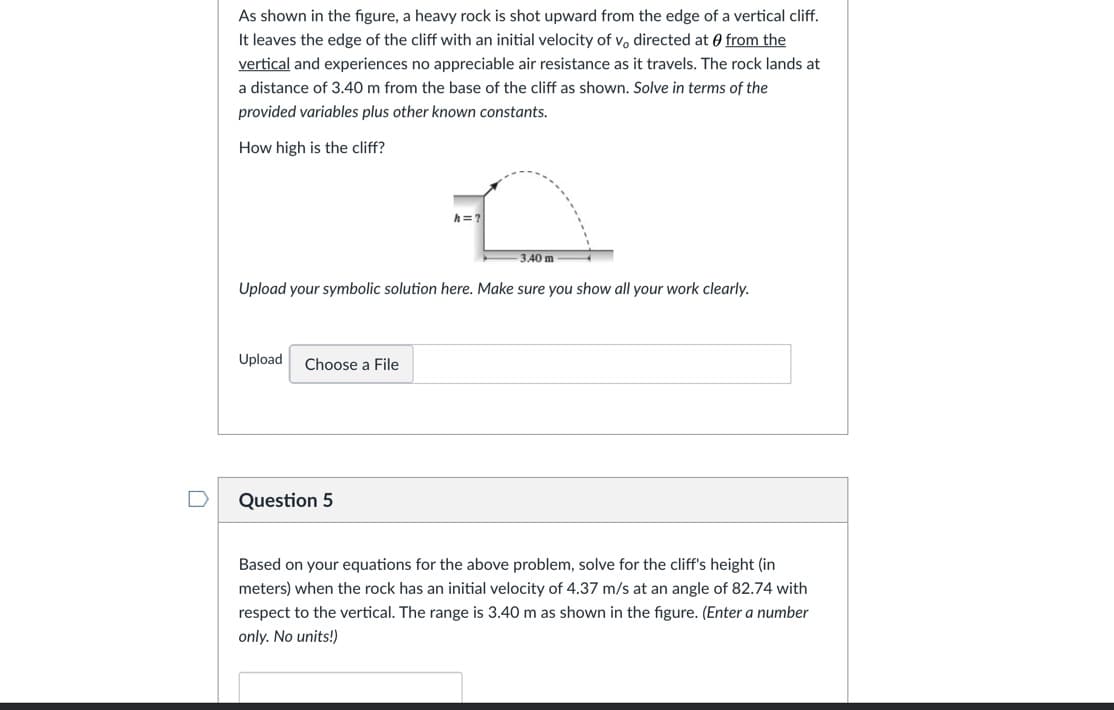As shown in the figure, a heavy rock is shot upward from the edge of a vertical cliff. It leaves the edge of the cliff with an initial velocity of v, directed at 0 from the vertical and experiences no appreciable air resistance as it travels. The rock lands at a distance of 3.40 m from the base of the cliff as shown. Solve in terms of the provided variables plus other known constants. How high is the cliff? h= ? 3.40 m Upload your symbolic solution here. Make sure you show all your work clearly. Upload Choose a File Question 5 Based on your equations for the above problem, solve for the cliff's height (in meters) when the rock has an initial velocity of 4.37 m/s at an angle of 82.74 with respect to the vertical. The range is 3.40 m as shown in the figure. (Enter a number only. No units!)
As shown in the figure, a heavy rock is shot upward from the edge of a vertical cliff. It leaves the edge of the cliff with an initial velocity of v, directed at 0 from the vertical and experiences no appreciable air resistance as it travels. The rock lands at a distance of 3.40 m from the base of the cliff as shown. Solve in terms of the provided variables plus other known constants. How high is the cliff? h= ? 3.40 m Upload your symbolic solution here. Make sure you show all your work clearly. Upload Choose a File Question 5 Based on your equations for the above problem, solve for the cliff's height (in meters) when the rock has an initial velocity of 4.37 m/s at an angle of 82.74 with respect to the vertical. The range is 3.40 m as shown in the figure. (Enter a number only. No units!)
Related questions
Question
As shown in the figure, a heavy rock is shot upward from the edge of a vertical cliff. It leaves the edge of the cliff with an initial velocity of vo directed at θ from the vertical and experiences no appreciable air resistance as it travels. The rock lands at a distance of 3.40 m from the base of the cliff as shown. Solve in terms of the provided variables plus other known constants.
How high is the cliff?
Based on your equations for the above problem, solve for the cliff's height (in meters) when the rock has an initial velocity of 4.37 m/s at an angle of 82.74 with respect to the vertical. The range is 3.40 m as shown in the figure. (Enter a number only. No units!)

Transcribed Image Text:As shown in the figure, a heavy rock is shot upward from the edge of a vertical cliff.
It leaves the edge of the cliff with an initial velocity of v, directed at 0 from the
vertical and experiences no appreciable air resistance as it travels. The rock lands at
a distance of 3.40 m from the base of the cliff as shown. Solve in terms of the
provided variables plus other known constants.
How high is the cliff?
h= ?
3.40 m
Upload your symbolic solution here. Make sure you show all your work clearly.
Upload
Choose a File
Question 5
Based on your equations for the above problem, solve for the cliff's height (in
meters) when the rock has an initial velocity of 4.37 m/s at an angle of 82.74 with
respect to the vertical. The range is 3.40 m as shown in the figure. (Enter a number
only. No units!)
Expert Solution
This question has been solved!
Explore an expertly crafted, step-by-step solution for a thorough understanding of key concepts.
This is a popular solution!
Trending now
This is a popular solution!
Step by step
Solved in 4 steps
